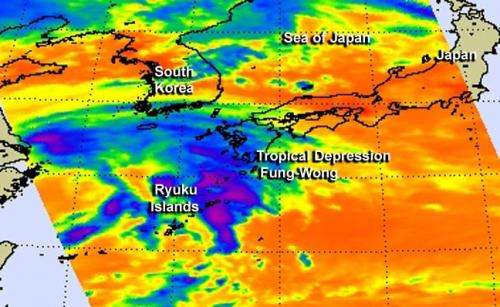NASA sees the end of post-depression Fung-Wong

Tropical Depression Fung-Wong looked more like a cold front on infrared satellite imagery from NASA than it did a low pressure area with a circulation.
NASA's Aqua satellite passed over Tropical Depression Fung-Wong on Sept. 23 at 12:23 a.m. EDT. The Atmospheric Infrared Sounder or AIRS instrument that flies aboard Aqua gathered infrared temperature data on the storm's clouds. The data was false-colored at NASA's Jet Propulsion Laboratory, Pasadena, California and showed that the storm resembled a frontal system more than a depression. The center of circulation was southwest of the bulk of thunderstorms and showers, which resembled a curved front. The strongest thunderstorms had cloud-top temperatures near -63F/-53C, and were over Japan's northern Ryuku Islands.
The Joint Typhoon Warning Center issued the final bulletin on Fung-Wong on Sept. 23 at 1500 UTC (11 a.m. EDT) when it was centered about 351 miles west of Sasebo, Japan, near 32.4 north latitude and 122.8 east longitude. At the time, the depression had maximum sustained winds near 30 knots (34.5 mph/55.5 kph). It was moving to the northeast at 11 knots (12.6 mph/20.3 kph).
On Sept. 24, the remnants of Fung-Wong, now an extra-tropical storm continued moving to the northeast and into the tropical cyclone history books.
Provided by NASA's Goddard Space Flight Center




















